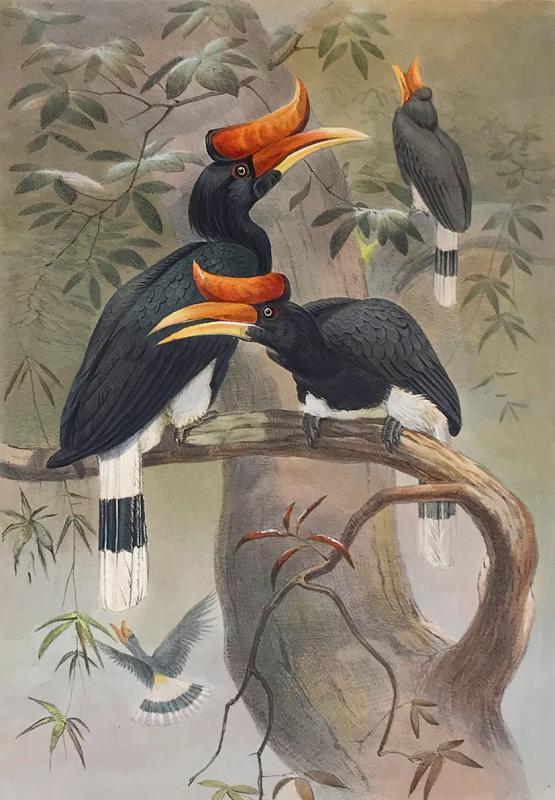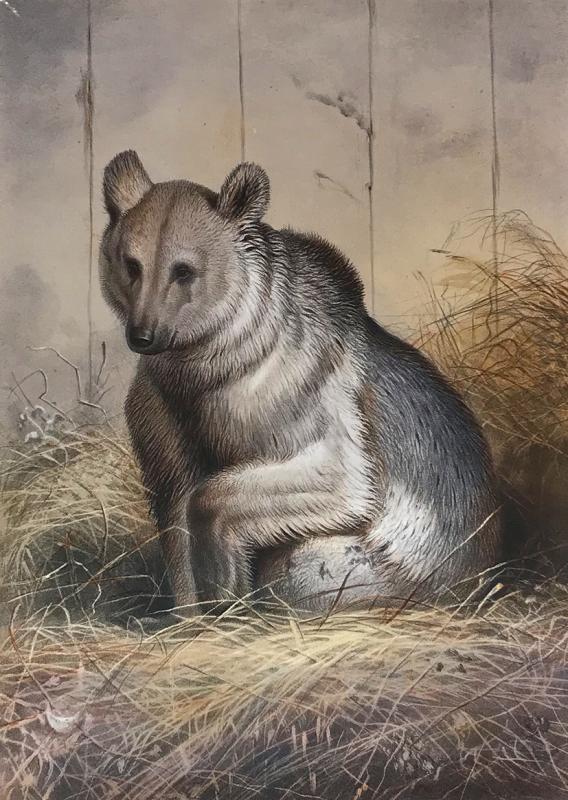Antiquariat MICHAEL KÜHN
WOLF, Joseph.  Auf Merkliste setzen
Auf Merkliste setzen
Zoological Sketches by J.W. made for the Zoological Society of London, from animals in their vivarium, in the Regent’s Park, edited with notes by Philip Lutley Sclater. 2 Vols. London: Henry Graves and Company, (1856 -) 1861 - 1867. Folio (584 x 435 mm.) Vol. 1: hand-colored lithographic title, lithographic title, letterpress title, list of subscribers, preface and list of plates; vol. 2: hand-colored lithographic title mounted, letterpress title, preface and list of plates. Some temporary letterpress leaves to the second series present. Together, 100 fine hand-colored lithographic plates, drawn on stone by Joseph Smit after the drawings of Joseph Wolf, each plate cut to the edge of the image and mounted on thin card in imitation of watercolors (ca. 350 x 240 mm on boards: 580 x 440 mm), with captions printed in gilt, one text leaf to each plate. The text leaves to the first series are smaller as those for the second series, light spotting throughout, heavier at beginning and end of the volumes, predominantly affecting text, leaves frayed at margins or with small marginal closed tears, not affecting illustrations or text, loosely inserted in contemporary red morocco-backed box, boxes bumped at extremities, box for volume I becoming fragile.
An exceptional collection of 100 plates after Joseph Wolf’s drawings, commissioned by the Zoological Society in 1852 and depicting particularly rare animals from the Society’s vivarium in Regent’s Park. The work was commissioned by the Council of the Zoological Society in 1852, to provide „an accurate artistic record of the living form and expression of the many rare species of animals which exist from time to time in the menagerie“. The council chose Wolf, already well-known for his work for the ornithologists Rüppell and Gould. Joseph Wolf captured the animals in watercolors and on the basis of which Joseph Smit made lithographs. The plates were issued monthly with the accompanying temporary text for parts I-VII written by David William Mitchell, secretary to the society. On Mitchell’s death in 1859, Philip Lutley Sclater undertook the completion of the work, selecting the subjects and writing both the temporary letterpress and the permanent text which was issued with the thirteenth and final part. Joseph Wolf was already established as the illustrator of choice for figures including John Gould and David Livingstone and Charles Darwin, and the brief given was to produce “an accurate artistic record of the living form”. Regent’s Park, now London Zoo, was founded in 1828 for the purpose of scientific observation of wild animals from all parts of the British Empire. “In the year 1852 the Council of the Zoological Society […] resolved to commence the formation of a series of original water-color drawings […]. For this purpose the Council were fortunate enough to secure the services of Mr. Joseph Wolf, who may be fairly said to stand alone in intimate knowledge of the habits and forms of Mammals and of Birds. …“ Joseph Wolf was born on 22 January 1820 in Mörz (Germany). He was trained as a lithographer in Münster, but also mastered the work with pencil, water and oil paints, and coal. He worked in different places in Europe before coming to London in 1840 to work at the British Museum as an animal illustrator. By that time, he had already made a name for himself with his illustrations, especially of birds. Sir Edwin Landseer described him as “… without exception, the best all-round animal painter that ever lived. …” (Palmer 1895, p. 283). In 1843, Wolf illustrated the famous falcon book „Traité de Fauconnerie“ for the Leiden zoologist Hermann Schlegel. The twelve large-format lithographs of hawks and falcons launched his career as an animal illustrator. He used not only bird skins as models, but also live animals that he had caught especially for this commission. The young artist succeeded in capturing the characteristic behavior of the birds of prey without neglecting the anatomical details. The shape and drawing of the plumage are reproduced with photographic accuracy. The Zoological Society appointed Wolf as its resident artist in 1861. Wolf, who until then only sketched animals in the wild, always dealt with the self-assertion of the individual and incorporated this into his works. The housing of the animals in the zoo in which they did not show their natural behavior was therefore a challenge for him. Animals that came to Regent’s Park in the 19th century often had a long, exhausting journey behind them. Wolf wrote “… for sometimes, when they arrived, they were in a miserable state, and hardly I knew what to make of them. I used to do two or three of these drawings in a day, if the material were good. All these were vignettes only; but I took care to get the true character of the animal” (Palmer 195, p. 110). In addition to the embellished depictions of the individuals, most of the 100 plates show the zoo animals in an ideal, natural environment. A few, however, provide insights into zoo life and depict the animals in their enclosures or provide a view of the visitors. Although the animals are described anonymously by Mitchell and Sclater, the records of the Zoological Society allow us to deduce which individuals of Regent Park’s Wolf drew. The hippopotamus bull Obaysh came to Regent’s Park as a calf on 25 May 1850 and quickly became a crowd puller. In 1854, he got a companion, Adhela. On plate 27 (part II) are two adult hippos, as well as a herd in the background, a mother with a calf and a western swamphen in a natural habitat. Since Joseph Wolf himself never visited Africa, he relied on third party sources for the design of the environment. For all the hippopotami depicted, especially the two individuals in the foreground, Obaysh and Adhela were probably models. Their names are not mentioned in the text and the representation of the right side of the body makes it impossible to identify Obaysh by a characteristic scar on his left side. As Obaysh and Adhela were the only hippos in the zoo, Wolf used different sketches of them for the herd to show different behaviors of the species. The situation is similar with plate 24 (part II), where a herd of elephants shows up in a supposedly natural environment. Probably Jumbo, who came to Regent’s Park on 26 June 1865, and Alice were depicted. This plate makes it clear that Wolf’s depiction of zoo animals does not show their natural behavior. The picture of the bull elephant together with the cow and a calf rather reflects the ideal of a Victorian family, as bull elephants are rouges. Furthermore, in African elephants, both females and males have tusks but the cow elephant shown here does not seem to have any. This can be explained by the fact that Alice was only 2 years old when Wolf made his sketches, and her tusks were apparently not yet fully developed. Plate XVII (part I) is one of the few that shows an animal in its zoo enclosure. The almost portrait-like drawing shows a Syrian Bear on straw in front of a board wall. It is not possible to take a closer look at the surroundings, e.g. to determine whether he lives together with other animals of the same species or to measure the dimensions of the enclosure. By depicting the bear in its actual accommodation, Wolf focuses on the animal’s personality; the bear no longer remains anonymous. The accompanying text also mentions that the bear was a gift from the Persian Gulf and arrived in London in August 1851. Despite their idealization and partial embellishment, they remain true to their scientific purpose and are an outstanding example of 19th century European animal painting.- Palmer, A. H. The life of Joseph Wolf,: animal painter. London: Longmans, Green, 1895; Nicole Ricarda Susset. Lebendigkeit im Bild: Joseph Wolf und die Tiermalerei im 19. Jahrhundert (2013); Karl Schulze-Hagen. Joseph Wolf (1820-1899), Tiermaler. Marburg an der Lahn: Basilisken-Presse, 2000; Anker 539; Fine Bird Books (1990), pp. 158; Nissen IVB 1012; Wood, p. 633; BM(NH) V, pp. 2349.
25000,- EUR Sachgebiete: Jagd, Mappenwerke, Naturwissenschaften, Ornithologie, Zoologie Kontakt zum
inkl. 7% USt.










